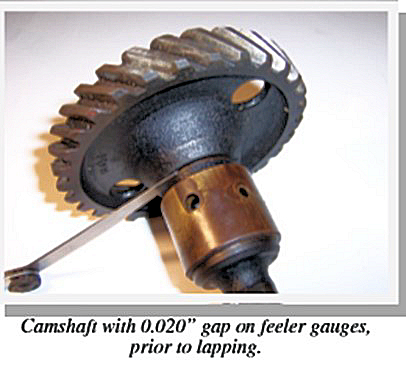Camshaft clatter
Fate caught up with my í37 Mk2 Ruby
one late afternoon. A harsh machine gun-like rattle occurred at various revs and
loads and sounded a bit like small end knock Ė but an Austin Seven doesnít
suffer with that problem especially when the pistons and small end clamping
bolts are new. It didnít sound like the centre main bearing; that too was new
and Iíd had previous experience of that noise. It was happening under load, so
it was unlikely to be big end problems. With the engine out for a major
inspection and investigation, the elusive problem was identified. With the block
off, and the rods disconnected and removed, I heard the same metallic clatter as
I rotated the camshaft timing gear. There was excessive end float somewhere on
the camshaft. I considered the alternatives - removing the end float at the rear
camshaft bearing seemed a possibility, using a wavy shim washer to take up the
excess clearance or to put a shim of the right thickness to take up the
clearance between the front camshaft bearing and the timing gear. The final
consideration, and the one suggested by Woodrow in the Austin Seven Manual (page
A247) is to lap the taper of the timing gear on the camshaft until there is a
clearance of 0.002Ē between the timing gear face and the front face of the
bronze bearing and that was the chosen method, because it used no extra
components.
In lapping the two parts, there is
minimal wear to the case hardened camshaft, bu t
the timing gear bore, being softer becomes enlarged and the gap between gear and
bearing reduces. Measuring the gap produced a staggering reading of 0.020Ē, TEN
times what is required. No wonder the camshaft was rattling violently back and
forth as the cams repeatedly bashed against the tappets, aided and abetted by
the skewed timing gears.
t
the timing gear bore, being softer becomes enlarged and the gap between gear and
bearing reduces. Measuring the gap produced a staggering reading of 0.020Ē, TEN
times what is required. No wonder the camshaft was rattling violently back and
forth as the cams repeatedly bashed against the tappets, aided and abetted by
the skewed timing gears.
Repeated rubbing down with first coarse and later fine valve grinding paste
produced the fine grey finish to give the .002Ē clearance. Hold the camshaft
between pieces of lead sheet to produce soft holding jaws in the vice, and
remember when finally assembling the camshaft components to fit the woodruff key
that holds the timing gear in place relative to the shaft. If you donít, it will
be probably be impossible to get the engine to run!
Itís not a difficult task, but a
considerable amount of dismantling of the engine is necessary, so allow plenty
of time to do the job. When reuniting the camshaft assembly with the crankcase
itís worth checking that the square headed screw that secures the bearing to the
crankcase is a good fit because any wear between screw and bearing needs to be
corrected or the rattle will still be there!
Bob Kneale
With thanks to the Cornwall A7C newsletter
 t
the timing gear bore, being softer becomes enlarged and the gap between gear and
bearing reduces. Measuring the gap produced a staggering reading of 0.020Ē, TEN
times what is required. No wonder the camshaft was rattling violently back and
forth as the cams repeatedly bashed against the tappets, aided and abetted by
the skewed timing gears.
t
the timing gear bore, being softer becomes enlarged and the gap between gear and
bearing reduces. Measuring the gap produced a staggering reading of 0.020Ē, TEN
times what is required. No wonder the camshaft was rattling violently back and
forth as the cams repeatedly bashed against the tappets, aided and abetted by
the skewed timing gears.